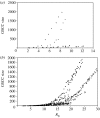Demographic structure and pathogen dynamics on the network of livestock movements in Great Britain
- PMID: 16846906
- PMCID: PMC1635475
- DOI: 10.1098/rspb.2006.3505
Demographic structure and pathogen dynamics on the network of livestock movements in Great Britain
Abstract
Using a novel interpretation of dynamic networks, we analyse the network of livestock movements in Great Britain in order to determine the risk of a large epidemic of foot-and-mouth disease (FMD). This network is exceptionally well characterized, as there are legal requirements that the date, source, destination and number of animals be recorded and held on central databases. We identify a percolation threshold in the structure of the livestock network, indicating that, while there is little possibility of a national epidemic of FMD in winter when the catastrophic 2001 epidemic began, there remains a risk in late summer or early autumn. These predictions are corroborated by a non-parametric simulation in which the movements of livestock in 2003 and 2004 are replayed as they occurred. Despite the risk, we show that the network displays small-world properties which can be exploited to target surveillance and control and drastically reduce this risk.
Figures







 ) to GSCC size under the effect of random removal of links (filled diamonds) and targeted removal of farm-to-market links (open diamonds), where the farm has previously bought from a market. Data from four-week period starting from 19 May 2004, total links=24 589, of which 1539 are the targeted farm-to-market following market–farm links.
) to GSCC size under the effect of random removal of links (filled diamonds) and targeted removal of farm-to-market links (open diamonds), where the farm has previously bought from a market. Data from four-week period starting from 19 May 2004, total links=24 589, of which 1539 are the targeted farm-to-market following market–farm links.References
-
- Albert R, Jeong H, Barabasi A.L. Error and attack tolerance of complex networks. Nature. 2000;406:378–382. 10.1038/35019019 - DOI - PubMed
-
- Alexandersen S, Kitching R.P, Mansley L.M, Donaldson A.I. Clinical and laboratory investigations of five outbreaks of foot-and-mouth disease during the 2001 epidemic in the United Kingdom. Vet. Rec. 2003a;152:489–496. - PubMed
-
- Alexandersen S, Quan M, Murphy C, Zhang Z. Studies of quantitative parameters of virus excretion and transmission in pigs and cattle experimentally infected with foot-and-mouth disease virus. J. Comp. Pathol. 2003b;129:268–282. 10.1016/S0021-9975(03)00045-8 - DOI - PubMed
-
- Anderson I. Foot & Mouth Disease 2001: Lessons to be Learned Inquiry Report. The Stationary Office; London, UK: 2002.
-
- Anderson R.M, May R.M. Infectious diseases of humans: dynamics and control. Oxford University Press; Oxford, UK: 1991.
Publication types
MeSH terms
Grants and funding
LinkOut - more resources
Full Text Sources
Medical

